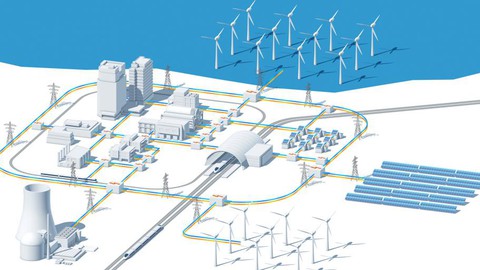
Smart Grid Technologies
Smart Grid Technologies, available at Free, has an average rating of 4.05, with 6 lectures, based on 92 reviews, and has 1578 subscribers.
You will learn about Smart Grid Fundamentals & Technologies This course is ideal for individuals who are Final Year Electrical Engineering Students It is particularly useful for Final Year Electrical Engineering Students.
Enroll now: Smart Grid Technologies
Summary
Title: Smart Grid Technologies
Price: Free
Average Rating: 4.05
Number of Lectures: 6
Number of Published Lectures: 6
Number of Curriculum Items: 6
Number of Published Curriculum Objects: 6
Original Price: Free
Quality Status: approved
Status: Live
What You Will Learn
- Smart Grid Fundamentals & Technologies
Who Should Attend
- Final Year Electrical Engineering Students
Target Audiences
- Final Year Electrical Engineering Students
This course will cover basics and various technologies of Smart Grid. This course covers various technologies like Outage Management Systems (OMS), Geographic Information System (GIS), Advanced Metering Infrastructure (AMI), Microgrid, Vehicle to Grid (V2G). Examples of various technologies are also covered.
The electrical grid has been cited as the greatest engineering achievement of the 20th century, but it now faces new challenges of sustainability, energy security, reliability, etc. Developed countries have a well-developed grid, and seek to improve it, while developing regions are still expanding their grids.
Over the past decade, the electricity generation, transmission and distribution landscape around the globe has changed drastically – in the traditional grid of the 20th century there were relatively few points of power generation or injection and millions of points of power consumption. With rapid proliferation of distributed and renewable generation, the 21st century grid will have numerous points of power injection as well as millions of points of consumption. Electric Vehicle (EV) roll out has further increased the complexity of the traditional electricity grid. To manage a grid with such increasing number of intermittent energy sources and EVs, smarter automation and IT systems are imperative. Peak load management through control of loads (such as through demand response, which can be considered a dynamic form of Demand Side Management, or DSM) has assumed high priority for electric utilities as there is a growing peak demand, leading to a supply gap during peak hours of consumption in many parts of the world. Beyond such drivers, increased deregulation, consumer choice for green power, which is inherently variable, and many more factors are giving thrust for the transition to smarter grids that can address all these issues.
A smart grid is an electrical grid with automation, communication and IT systems that can monitor power flows from points of generation to points of consumption (even down to the appliances level) and control the power flow or curtail the load to match generation in real time or near realtime. The increased visibility, predictability, and even control of generation and demand bring flexibility to both generation and consumption and enable the utility to better integrate intermittent renewable generation and also reduce costs of peak power. If the traditional grid was made secure only through over-engineering, a smart grid is cost-effective, nimble, responsive, and better engineered for reliability and self-healing operations.
Course Curriculum
Chapter 1: Introduction
Lecture 1: Introduction
Chapter 2: Smart Grid Fundamentals
Lecture 1: Smart Grid basics
Chapter 3: Microgrid
Lecture 1: Microgrids & its applications
Chapter 4: Outage Management System
Lecture 1: Outage Management System and GIS
Chapter 5: Advanced Metering Infrastructure
Lecture 1: AMI
Chapter 6: Vehicle to Grid (V2G)
Lecture 1: Vehicle to Grid
Instructors
-
Jaydeep Shah
Assistant Professor
Rating Distribution
- 1 stars: 6 votes
- 2 stars: 2 votes
- 3 stars: 15 votes
- 4 stars: 28 votes
- 5 stars: 41 votes
Frequently Asked Questions
How long do I have access to the course materials?
You can view and review the lecture materials indefinitely, like an on-demand channel.
Can I take my courses with me wherever I go?
Definitely! If you have an internet connection, courses on Udemy are available on any device at any time. If you don’t have an internet connection, some instructors also let their students download course lectures. That’s up to the instructor though, so make sure you get on their good side!
You may also like
- Top 10 Language Learning Courses to Learn in November 2024
- Top 10 Video Editing Courses to Learn in November 2024
- Top 10 Music Production Courses to Learn in November 2024
- Top 10 Animation Courses to Learn in November 2024
- Top 10 Digital Illustration Courses to Learn in November 2024
- Top 10 Renewable Energy Courses to Learn in November 2024
- Top 10 Sustainable Living Courses to Learn in November 2024
- Top 10 Ethical AI Courses to Learn in November 2024
- Top 10 Cybersecurity Fundamentals Courses to Learn in November 2024
- Top 10 Smart Home Technology Courses to Learn in November 2024
- Top 10 Holistic Health Courses to Learn in November 2024
- Top 10 Nutrition And Diet Planning Courses to Learn in November 2024
- Top 10 Yoga Instruction Courses to Learn in November 2024
- Top 10 Stress Management Courses to Learn in November 2024
- Top 10 Mindfulness Meditation Courses to Learn in November 2024
- Top 10 Life Coaching Courses to Learn in November 2024
- Top 10 Career Development Courses to Learn in November 2024
- Top 10 Relationship Building Courses to Learn in November 2024
- Top 10 Parenting Skills Courses to Learn in November 2024
- Top 10 Home Improvement Courses to Learn in November 2024






















